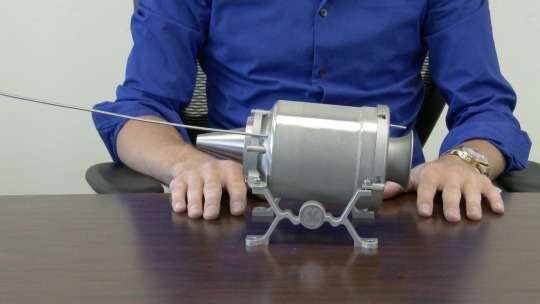Engineers 3D Print Mini Jet Engine by Melting Metal Powder
| Sami Ghanmi | | May 14, 2015 11:22 AM EDT |
(Photo : General Electric Engineers) 3D Printed Mini Jet Engine
A group of engineers at General Electric (GE) has developed a mini jet engine with a 3D printer that melts powdered metal.
According to a report, the mini jet engine has the ability to rotate 33,000 times per minute. The group consists of technicians and engineers from the Additive Development Center at General Electric Aviation.
Like Us on Facebook
Using this new method to manufacture engine components, according to the GE website, takes less time compared to conventional approaches.
One of the engineers said, "We wanted to see if we could build a little engine that runs almost entirely out of additive manufacturing parts."
"This was a fun side project," he added.
The printing process used by the engineers to create the mini jet engine is called Direct Metal Laser Melting (DMLM).
Engineer David Bartosik said the benefit of using this printing process is that it enables manufacturers to redesign the components with new geometries.
Greg Morris said, "Additive provides the ability to create geometry that cannot be made any other way."
"For the aerospace industry, additive is particularly attractive because it can create components in materials that are commonly used in aerospace such as nickel-based alloys, Titanium, etc."
"And we can make those parts with structures that provide design benefits, such as lattice structures that allow for substantial weight reductions, yet do not compromise the mechanical integrity of the part." Morris added.
Chinese scientists from the Chinese Academy of Sciences in Beijing had unveiled a new liquid-phase 3D printing method last year. Their method uses a metal alloy ink to allow the rapid manufacturing of 3D objects.
The use of additive manufacturing or 3D printing technology has also been getting a lot of attention in the automotive industry.
Earlier this year, researchers from the Department of Energy at Oak Ridge National Laboratory (ORNL) in the U.S. had successfully 3D printed a 1965 Shelby sports car. As part of the car's 50th anniversary, the ORNL researchers have intended to showcase the potential use of additive manufacturing for the automotive industry.
Tags3D Print Mini Jet Engine, 3D printing technology, Metal Powder, General Electric, GE, 3D-printer, Additive Manufacturing, engineers, Direct Metal Laser Melting, DMLM
©2015 Chinatopix All rights reserved. Do not reproduce without permission
EDITOR'S PICKS
-

Did the Trump administration just announce plans for a trade war with ‘hostile’ China and Russia?
-

US Senate passes Taiwan travel bill slammed by China
-

As Yan Sihong’s family grieves, here are other Chinese students who went missing abroad. Some have never been found
-

Beijing blasts Western critics who ‘smear China’ with the term sharp power
-

China Envoy Seeks to Defuse Tensions With U.S. as a Trade War Brews
-

Singapore's Deputy PM Provides Bitcoin Vote of Confidence Amid China's Blanket Bans
-

China warns investors over risks in overseas virtual currency trading
-

Chinese government most trustworthy: survey
-

Kashima Antlers On Course For Back-To-Back Titles
MOST POPULAR
LATEST NEWS
Zhou Yongkang: China's Former Security Chief Sentenced to Life in Prison

China's former Chief of the Ministry of Public Security, Zhou Yongkang, has been given a life sentence after he was found guilty of abusing his office, bribery and deliberately ... Full Article
TRENDING STORY

China Pork Prices Expected to Stabilize As The Supplies Recover

Elephone P9000 Smartphone is now on Sale on Amazon India

There's a Big Chance Cliffhangers Won't Still Be Resolved When Grey's Anatomy Season 13 Returns

Supreme Court Ruled on Samsung vs Apple Dispute for Patent Infringement

Microsoft Surface Pro 5 Rumors and Release Date: What is the Latest?










